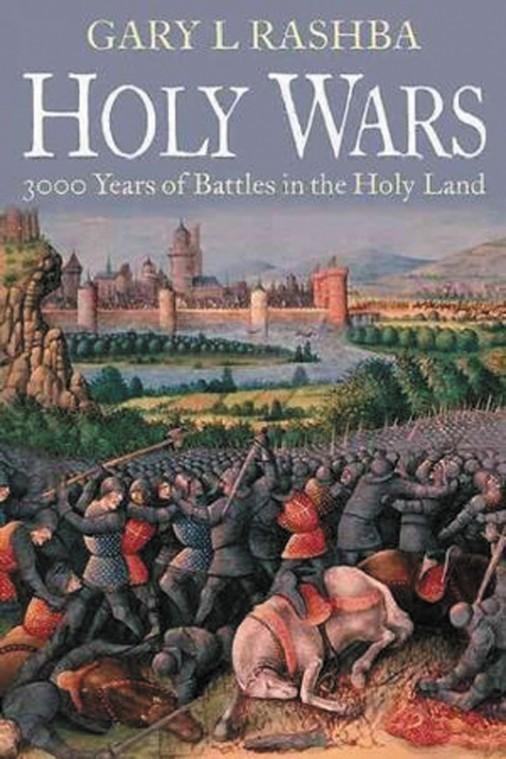‘Holy Wars’ chronicles 3,000 years of Holy Land conflict
Published March 7, 2012
The Land of Israel. Canaan. Palestine. Judah. The Hasmonean Kingdom. These are just a few of the names for the New Jersey-sized wedge of territory called “The Holy Land.” For the nearly 4,000 years of Jewish history and 3,000 years of Eretz Israel as a distinct political entity, the birthplace of Judaism, Christianity and Islam has been ravaged by bloody conflict, from the time that Joshua fought and won the post-Exodus Battle of Jericho, through the Crusades, the Napoleonic conquests, up to and including Israel’s ongoing conflicts with groups like Hamas and Hezbollah, the peace that the three monotheistic religions born in the Middle East profess to seek and for which they pray has been the most elusive goal.
Gary L. Rashba, the author of more than 30 articles on defense, aerospace and international topics and who has had a long-term relationship with Israel’s defense industries, deploys his expertise in his new book, “Holy Wars: 3,000 Years of Battles in the Holy Land” (Casemate, $32.95). In just 280 pages, Rashba, who has lived in Israel for the past 18 years, weaves a concise description of the entire sweep of the centuries of conflict in the Holy Land, which literally sits at the intersection of Asia, Africa and Europe. Rather than attempting a comprehensive description of the various major wars that have centered on the Land of Israel through the centuries, Rashba focuses on pivotal battles, starting with Joshua’s conquest of Jericho around 1210 BCE and culminating with Israel’s 1982 invasion of Lebanon. He does add a very useful epilogue, which summarizes the Israel-Hezbollah conflict, Operation Cast Lead and the current stalemated situation.
Covered in Rashba’s sharply honed narrative are key battles fought by the Philistines, Assyrians, Greeks, Romans, Arabs, Crusaders and Mamluks. In the case of the latter, the battle at Ayn Jalut was the first instance of a military defeat by the Mongols. No less a towering figure than Napoleon Bonaparte, whose reign overall was favorable to the status of the Jews within France and his conquered lands, was nonetheless frustrated in his efforts to tame the conflicts in Egypt and the Land of Israel through his conventional military tactics and strategies. For 500 years, what are now Israel, Jordan and the Palestinian Authority was under the jurisdiction of the Ottoman Empire, which by World War I was described as “the sick man of Europe.” After the World War I, Great Britain was assigned the Mandate of Palestine after the defeat of the Turks. During the British period, the famous Balfour Declaration was issued in 1917 by which “His Majesty’s Government” explicitly endorsed the right of the Jewish People to establish a “National Home” in Palestine.
Sadly, the Zionist dream of an independent state for the Jewish people was not realized before the Holocaust, but in its aftermath, David Ben-Gurion, Israel’s first Prime Minister, issued the Proclamation of Independence, declaring that the Jewish People had ended their 2,000-year exile to establish sovereignty for the first time since the Romans sacked Jerusalem and destroyed the Second Temple in the year 70.
Rashba describes Israel’s ability to defeat much stronger enemy forces as an enduring characteristic of the Jewish states, including the Maccabean Revolt against the Syrian-Greeks, which resulted in the establishment of the Third Jewish Commonwealth, the State of Judea in 167 BCE. The tactics of the vastly outnumbered Maccabees are studied at West Point, and have been emulated by small military units around the world through the centuries. Israel, which had a Jewish population of 625,000 in 1948, was invaded by five Arab nations with a total population of over 100 million. Despite these odds, Israel managed not only to win its War of Independence but to do so decisively, with the 1949 Armistice Lines exceeding the territory allotted to the Jewish State under the 1947 United Nations Partition Plan.
The author goes on to provide excellent, well-researched and succinct summaries of future conflicts, including the 1956 Sinai Campaign; the historic and heroic 1967 Six-Day War; the nearly catastrophic Yom Kippur War of 1973, and the first Lebanon War. Subsequent conflicts are summarized briefly in the epilogue. By including all major battles and conflicts from the biblical era to the present situation, Rashba has provided scholars and journalists as well as general readers with a convenient narrative of the centuries of conflict in the land whose inhabitants continue to pray for peace in a highly readable and accessible volume.















